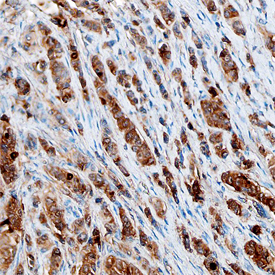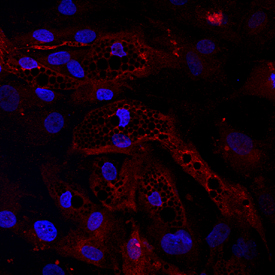Human ZAG Antibody Summary
Applications
Please Note: Optimal dilutions should be determined by each laboratory for each application. General Protocols are available in the Technical Information section on our website.
Scientific Data
 View Larger
View Larger
Detection of Human ZAG by Western Blot. Western blot shows lysates of human prostate tissue. PVDF membrane was probed with 1 µg/mL of Goat Anti-Human ZAG Antigen Affinity-purified Polyclonal Antibody (Catalog # AF4764) followed by HRP-conjugated Anti-Goat IgG Secondary Antibody (Catalog # HAF019). A specific band was detected for ZAG at approximately 40 kDa (as indicated). This experiment was conducted under reducing conditions and using Immunoblot Buffer Group 8.
 View Larger
View Larger
ZAG in Human Breast Cancer Tissue. ZAG was detected in immersion fixed paraffin-embedded sections of human breast cancer tissue using Goat Anti-Human ZAG Antigen Affinity-purified Polyclonal Antibody (Catalog # AF4764) at 10 µg/mL overnight at 4 °C. Before incubation with the primary antibody, tissue was subjected to heat-induced epitope retrieval using Antigen Retrieval Reagent-Basic (Catalog # CTS013). Tissue was stained using the Anti-Goat HRP-DAB Cell & Tissue Staining Kit (brown; Catalog # CTS008) and counterstained with hematoxylin (blue). Specific staining was localized to epithelial cells. View our protocol for Chromogenic IHC Staining of Paraffin-embedded Tissue Sections.
 View Larger
View Larger
ZAG in Human Mesenchymal Stem Cells. ZAG was detected in immersion fixed human mesenchymal stem cells differentiated into adipocytes using Goat Anti-Human ZAG Antigen Affinity-purified Polyclonal Antibody (Catalog # AF4764) at 10 µg/mL for 3 hours at room temperature. Cells were differentiated using using StemXVivo Osteogenic/Adipogenic Base Media (Catalog # CCM007) and StemXVivo Adipogenic Supplement (100X) (Catalog # CCM011). Cells were stained using the NorthernLights™ 557-conjugated Anti-Goat IgG Secondary Antibody (red; Catalog # NL001) and counterstained with DAPI (blue). Specific staining was localized to cytoplasm. View our protocol for Fluorescent ICC Staining of Stem Cells on Coverslips.
Reconstitution Calculator
Preparation and Storage
- 12 months from date of receipt, -20 to -70 degreesC as supplied. 1 month, 2 to 8 degreesC under sterile conditions after reconstitution. 6 months, -20 to -70 degreesC under sterile conditions after reconstitution.
Background: ZAG
ZAG (zinc-alpha 2 -glycoprotein; also ZA2G) is a 40 kDa, secreted member of the MHC class I family of proteins. It is produced by adipocytes and various epithelial cells that generate exocrine-type secretions. ZAG is reported to stimulate lipid breakdown and thus may play a role in lipid homeostasis. Mature human ZAG is 278 amino acids (aa) in length. It contains one MHC class I antigen region (aa 26-201) and a C2-type Ig-like domain (aa 207-292). Two alternate splice forms exist; one shows a 66 aa substitution for the C-terminal 30 aa, and a second shows a nine Lys substitution for aa 151-298. Mature human ZAG is 60% aa identical to mouse ZAG.
Product Datasheets
FAQs
No product specific FAQs exist for this product, however you may
View all Antibody FAQsReviews for Human ZAG Antibody
There are currently no reviews for this product. Be the first to review Human ZAG Antibody and earn rewards!
Have you used Human ZAG Antibody?
Submit a review and receive an Amazon gift card.
$25/€18/£15/$25CAN/¥75 Yuan/¥2500 Yen for a review with an image
$10/€7/£6/$10 CAD/¥70 Yuan/¥1110 Yen for a review without an image

